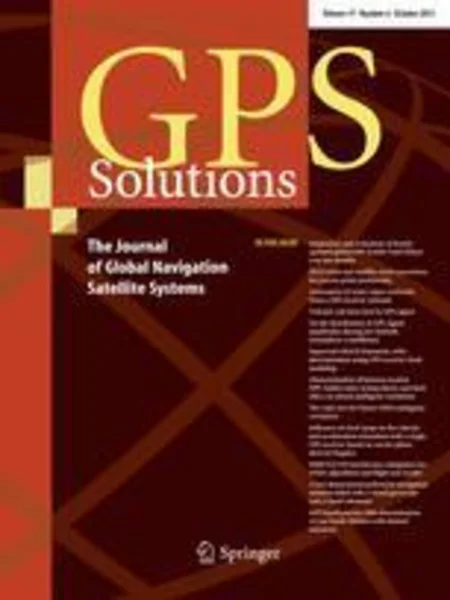-
urtk: undifferenced network rtk positioning
جزئیات بیشتر مقاله- تاریخ ارائه: 1392/07/24
- تاریخ انتشار در تی پی بین: 1392/07/24
- تعداد بازدید: 1241
- تعداد پرسش و پاسخ ها: 0
- شماره تماس دبیرخانه رویداد: -
standard network rtk has been widely used since it was proposed in the mid-1990s. rovers can obtain high-precision estimates of position by resolving double-differenced (dd) ambiguities. the focus of this study is a new undifferenced network rtk method, abbreviated as urtk hereafter, based on undifferenced (ud) observation corrections whose single-differenced (sd) ambiguities between satellites can be resolved in several seconds. the tools for studying the real-time realization of the new method are our developments of logical schemes that have the capability for the real-time modeling of a reference network and the instantaneous resolution of sd ionosphere-free (if) ambiguities at a single station. this research demonstrates the validity of modeling regional ud-unmodeled errors on the ground and examines the maximum differences when compared to modeling the errors using ionospheric pierce points (ipp). with data collected at 48 stations from a cors network in shanxi province (sxcors) in china through may 21, 2010, the efficiency of the presented real-time strategies is validated using igs final products in a postprocessing mode. the results verify that more than 83 % of sd wide-lane (wl) ambiguity can be fixed with 5 s of observation data, and the average resolution time of all the wl tests is 4.96 s. more than 80 % of sd l1 ambiguity can be fixed within 5 s, and the average resolution time is only 6.66 s. rovers could gain rapidly centimeter-level absolute positioning service, comparable to standard network rtk. in addition, the urtk method transforms the fixed dd-ambiguities of the reference network into ud-ambiguities, and it does not need to set the base station and base satellite. since the ud-corrections are modeled for each common visible satellite, it breaks down the connections between stations and satellites of the dd-corrections in the current network rtk. the ud-corrections can be broadcast by the base station and automatically selected and optimized by a rover during the real-time kinematic processing, thus avoiding ambiguity in reinitialization due to the change of reference, so it should be very flexible and useful for a wide range of applications.
مقالات جدیدترین رویدادها
-
استفاده از تحلیل اهمیت-عملکرد در ارائه الگوی مدیریت خلاقیت سازمانی و ارائه راهکار جهت بهبود
-
بررسی تاثیر ارزش وجوه نقد مازاد بر ساختار سرمایه شرکت های پذیرفته شده در بورس اوراق بهادار تهران
-
بررسی تأثیر سطح افشای ریسک بر قرارداد بدهی شرکت های پذیرفته شده در بورس اوراق بهادار تهران
-
بررسی تأثیر رتبه بندی اعتباری مبتنی بر مدل امتیاز بازار نوظهور بر نقد شوندگی سهام با تأکید بر خصوصی سازی شرکت ها
-
تأثیر آمیخته بازاریابی پوشاک ایرانی بر تصویر ذهنی مشتری پوشاک ایرانی (هاکوپیان)
-
بررسی رفتار ساختمان های بتن آرمه بهسازی شده با دیوارهای برشی آلومینیومی
-
ارزیابی درجه تراکم دانه بندی گسسته و پیوسته سنگدانه ها در حالت دو بعدی
-
بررسی طراحی بهینه و عملکرد لرزه ای میراگرهای ویسکوز الحاقی در نواحی زلزله خیز
-
طرح دعاوی خصوصی از نظر ضمان قهری و ضررو زیان وارد در دادگاه های عمومی
-
بررسی نحوه طراحی و رتبه بندی سایت در سامانه leed و breeam و امکان سنجی آن با مقررات ملی ساختمان در ایران
مقالات جدیدترین ژورنال ها
-
مدیریت و بررسی افسردگی دانش آموزان دختر مقطع متوسطه دوم در دروان کرونا در شهرستان دزفول
-
مدیریت و بررسی خرد سیاسی در اندیشه ی فردوسی در ادب ایران
-
واکاوی و مدیریت توصیفی قلمدان(جاکلیدی)ضریح در موزه آستان قدس رضوی
-
بررسی تاثیر خلاقیت، دانش و انگیزه کارکنان بر پیشنهادات نوآورانه کارکنان ( مورد مطالعه: هتل های 3 و 4 ستاره استان کرمان)
-
بررسی تاثیر کیفیت سیستم های اطلاعاتی بر تصمیم گیری موفق در شرکتهای تولیدی استان اصفهان (مورد مطالعه: مدیران شرکتهای تولیدی استان اصفهان)
-
نقش صله رحم در سلامت جسمی و روحی خانواده با تمرکز بر گزاره های اسلامی
-
بررسی تاثیر یارانه سفر بر توسعه گردشگری؛ مطالعه موردی: گردشگران شهر مشهد مقدس
-
evaluate the use of recycled asphalt pavement (rap) in the construction of roller compacted concret pavement (rcc)
-
the transformation of aesthetics in architecture from traditional to modern architecture: a case study of the yoruba (southwestern) region of nigeria
-
exploring in silico drug design and pharmacokinetics study for identification of potent antidepressant agents




سوال خود را در مورد این مقاله مطرح نمایید :